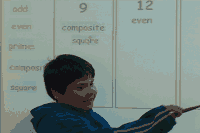One of the basic ways to use a visualizer (document imaging camera) is like a colorful overhead projector. You can do that by hooking up a VGA from the projector to the laptop and a VGA from the projector to the visualizer, you can toggle between the two by pressing “Source Selection.” You may have to first press Fn and F8 to get the laptop to show up.
 A more powerful way to use a visualizer is to install its software on your computer. The benefit is that you can annotate student journals, take snapshots of student work and more. The only (small) problem is that it slows down how quickly you see what is placed under the visualizer. You can set up the visualizer by installing the software and then connect the laptop to the projector with the VGA and the laptop to the visualizer with USB, you can open the visualizer on the laptop as a window and use it like that. Then within the computer you can toggle between websites, the visualizer, PowerPoints, etc…
A more powerful way to use a visualizer is to install its software on your computer. The benefit is that you can annotate student journals, take snapshots of student work and more. The only (small) problem is that it slows down how quickly you see what is placed under the visualizer. You can set up the visualizer by installing the software and then connect the laptop to the projector with the VGA and the laptop to the visualizer with USB, you can open the visualizer on the laptop as a window and use it like that. Then within the computer you can toggle between websites, the visualizer, PowerPoints, etc…




